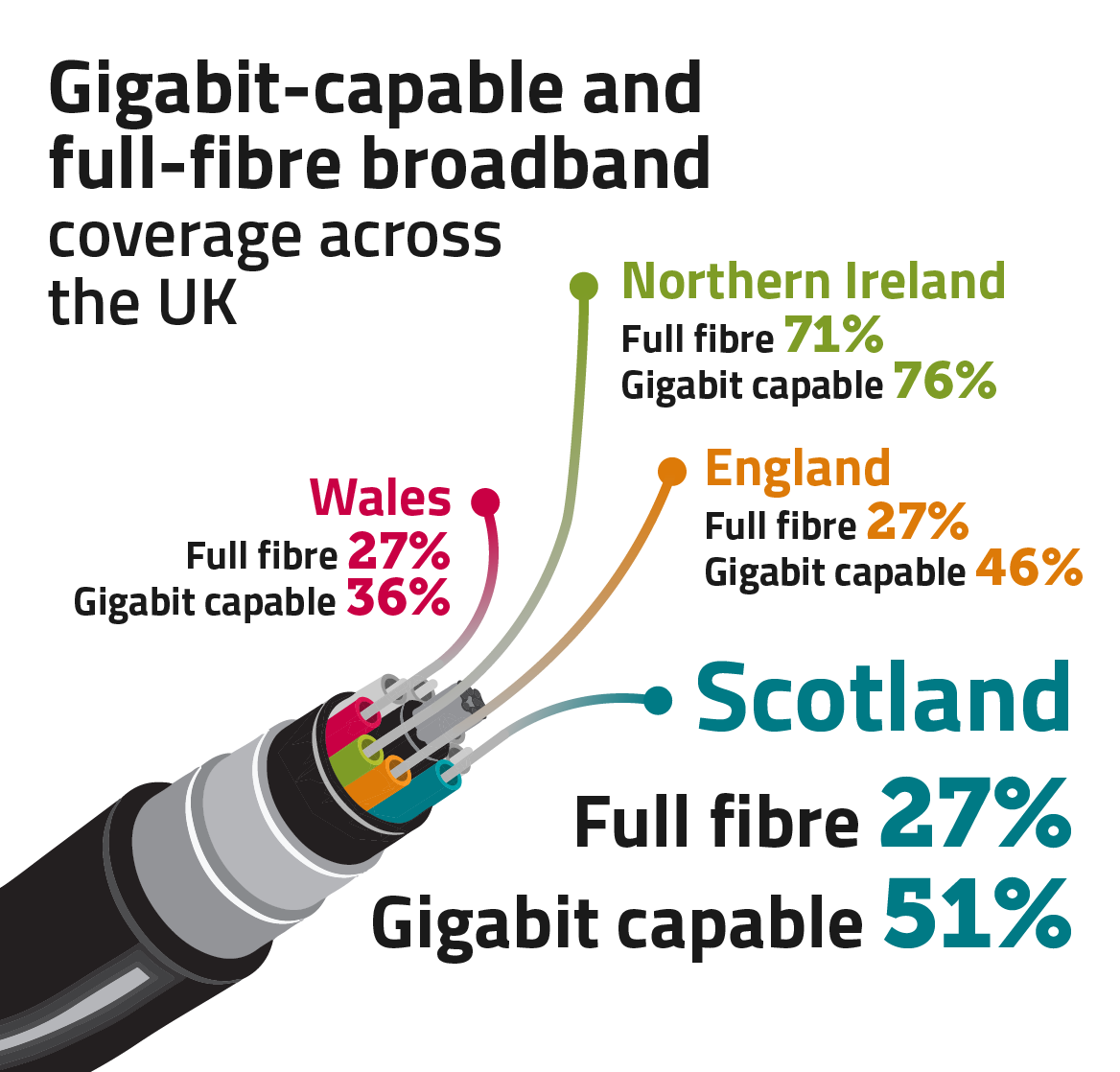
- Full-fibre broadband now available to more than a quarter of Scottish homes, as rollout accelerates
- Thousands have already boosted their broadband, but many others are yet to take advantage
- Properties without access to decent broadband falls to lowest ever level, but more to do to reach remaining 30,000 homes
- 4G continues to underpin mobile experiences with 82% of Scotland’s landmass having access to good 4G coverage from at least one of the four mobile operators. Ninety-six per cent of rural premises are predicted to receive a good service from at least one operator
Fast, reliable internet connections are now available to more Scottish homes than ever before, allowing over 700,000 thousand families to download their favourite Christmas movie in less than a minute.

Ofcom’s annual Connected Nations Scotland report on the availability of broadband and mobile services across Scotland and the UK, reveals that the rollout of future-proof, full-fibre technology is accelerating at its fastest ever rate. Full-fibre broadband is now available to 717,000 (27%) of homes in Scotland – an increase of 280,000 premises in the last year – and the highest year-on-year increase seen on full-fibre coverage so far.
By September 2021, Gigabit-capable broadband was available to over half of Scottish homes (1.3 million), and we expect this will quickly increase further since Virgin Media O2 completed the upgrade of its cable network in Scotland. As well as delivering faster speeds, these services are more reliable than older broadband technologies. Commercial build-out of full-fibre networks has continued apace with Openreach, Virgin Media and CityFibre rapidly expanding their Scottish networks.
Superfast broadband coverage availability remains stable at 94% of homes in Scotland, and over two-thirds of homes that have access to superfast broadband have now taken up a superfast service. However, many others are yet to take advantage of even faster services, with less than a quarter (22%) of homes upgrading to faster, more reliable full-fibre services where available.
Why would I need full fibre?
Full-fibre connections – along with upgraded cable networks – can deliver download speeds of up to 1 Gbit/s.[1] At this speed, families with full-fibre services could download Christmas film favourite Elf in High-Definition in less than a minute, compared with around 25 minutes for those with superfast broadband (30 Mbit/s).

Full fibre can better support data-hungry households where family members need to stream, work, game, video-call and study online at the same time. And in a year when many people continue to work from home due to the coronavirus pandemic, average monthly data use grew to 446 GB per connection – up from 327 GB per connection in 2019.
Connecting the hardest to reach households
Around 30,000 Scottish homes (1.1%) still do not have access to a ‘decent’ broadband connection – defined as offering download speeds of 10 Mbit/s and upload speeds of 1 Mbit/s. At this speed, it could take up to an hour and a half to download an HD film.
The UK and Scottish Governments continue to deliver projects aimed at making sure people in the hardest-to-reach areas can get the connections they need.
Many homes have multiple devices on the go at the same time to work, learn and play – and the festive holidays can see a particular battle for bandwidth.
Full-fibre is helping meet those demands, with families benefitting from faster speeds and more reliable connections. But some homes in rural areas still struggle to get decent broadband, and we are committed to working with industry and the Scottish and UK Governments to look at alternative technology and funding solutions for these hard-to-reach properties.
Glenn Preston, Ofcom’s Scotland Director
Mobile in Scotland
Mobile Network Operators have continued to deploy 5G networks across the UK this year, with 8% of the c6,500 UK sites being in Scotland. Many 5G deployments are focused on towns and cities – such as Glasgow, Edinburgh and Stirling – in order to provide enhanced capacity to 3G and 4G services in more populated areas.
4G continues to underpin mobile experience in Scotland and mobile coverage is generally stable; 82% of Scotland’s landmass has access to good 4G coverage from at least one of the mobile operators (up from 81% in 2020), but only 45% has coverage from all 4 operators (up from 44% in 2020). Ninety-six per cent of rural premises are predicted to receive a good service from at least one operator.
Coverage is set to improve over the coming years with the implementation of the Shared Rural Network and the Scottish Government’s 4G Mobile Infill programme.
Notes to editors
- By September 2021, Gigabit-capable broadband was available to 1.3 million Scottish homes (51%). This includes full-fibre and upgraded cable networks that are capable of delivering download speeds of 1Gbit/s or higher. This figure that has since further increased following Virgin Media O2 completing the upgrade of its network.
- 5G rollout is well underway in Scotland. We estimate that 5G is available from at least one mobile network operator in the vicinity of 35-48% of premises. The range is based on the information provided to us by operators and informed by our own measurement work. Take up remains modest, and the majority of consumers continue to rely on 4G, 3G and 2G.
- An interactive version of the report, also published today, allows people to look up how coverage compares in their area.
- The International Broadband Scorecard compared broadband availability and take-up across 17 different nations.
- Improving your wifi experience
- Estimated download speeds used in the Elf graphic are indicative
